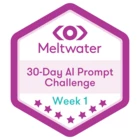If you’re here, I’m guessing you’re either considering influencer marketing for your brand or you’re interested in learning more about leveraging influencers to meet your marketing objectives.Either way, you’ve come to the right place! By the end of this article, you’ll be able to identify the perfect influencers that suit your brand, partner with those influencers to yield desired results, and create viral content together.
What is (or isn’t) Influencer Marketing?
Let’s begin by defining exactly what we mean when we talk about influencers. Influencer marketing is often described as brands partnering with popular figures like celebrities and bloggers with a large following for brand exposure, but the true meaning is much broader. While that definition is not totally incorrect, the most basic definition of influencer is simply someone who can influence others.
I prefer to think of influencer marketing as a form of integrated marketing that leverages individuals with a significant social media presence to inspire or promote a desired action, such as promoting your product or service.
The term “influencer marketing” is often misunderstood or misinterpreted. For example, the terms “content creator” and “influencer” are frequently used interchangeably, but there is a slight difference. Content creators create content solely to educate their audience, while influencers create content to grow their followership,attract brands for partnership, and earn a fee from sales made through them. Contrary to popular belief, influencers are not necessarily celebrities. Celebrities and created personas (think of brand mascots like Kellogg’s Tony the Tiger) have been acting as influencers for much longer, but in today’s landscape influencers can be anyone and be anywhere, you just have to find them - or even create them.
Aside from literal brand mascots like Tony, “created” influencers can include people like Isaiah Mustafa from the legendary Old Spice ad series. In his case, Old Spice hired him as an actor to act as an influencer for the brand in the hopes that it could help “revive” Old Spice. The ad series did so well that it catapulted Isaiah to fame, and he almost became known more as “The Man Your Man Could Smell Like” than he was as himself. He, as an influencer, became synonymous with the brand.
Social media has amplified the voices of users, which has allowed some experts in their fields to rise to prominence through this unconventional path. This means that an influencer can be a HR professional on LinkedIn, a food blogger, or even a painter. They can have five million followers or five thousand - the only truly important thing is that they have a significant social media presence, and are able to create engaging posts to answer people’s questions, entertain them, educate them, or simply pique their interests.
How to effectively leverage influencers for your brand strategy
Now that I’ve convinced you that influencers are strategic partners worth pursuing, the next step is to dive in. However, this isn’t necessarily as easy as it sounds, and it helps to go into the world of influencer relationships with realistic expectations and a solid plan to deal with challenges as they arise. For example, because social media is saturated with individuals posing as influencers, you may run into difficulties finding the right influencers for your brand campaigns. These three points have served me well in planning out my influencer strategy, and it’s my hope they will help you too:
- Be clear about your objective: The first thing to consider when selecting an influencer is the objective of your campaign. Influencers all have their own strengths,weaknesses, and uniquestyles. For example, a given influencer may be great at creating engaging content centered around exposure/awareness for a product, but that same influencer may not be able to drive desired actions such as registrations, purchases, or downloads.
That’s why, depending on the objective of your campaign (awareness, acquisition, talkability/engagement, sales), it is advisable to weigh an influencer’s strengths and use them where they’ll have the most impact. It’s also important to remember that using a great influencer is no substitute for a strong strategy. A large following does not always translate to high engagement. Look for influencers whose posts get results in the form of high comments, shares, and impressions. If an influencer isn’t already getting engagement, it’s unlikely that your campaign will perform any differently.
- Does your influencer fit your strategy?: This is one of the most common mistakes brands make. Whether these brands ignore influencer brand fit, do not understand their target audience, or are more concerned with making profit, inappropriate or inauthentic influencers can tank an otherwise stellar campaign.
At this stage, after you have carefully identified your campaign objective, ask yourself, do our brand values align with this influencer’s? Will our audience relate with them? Are they excited to work with my brand? Are they relevant for what I’m trying to sell? For example, a food blogger talking to the audience about cybersecurity courses is an obvious brand misalignment. They may reach people, but they aren’t necessarily trusted in that field. This means that they (and by extension, your brand) will be starting at a deficit when trying to inspire your audience to register for the course.
If you’re stuck on how to go about this, get back to basics: create audience personas, and use these to create matching influencer personas. This way, you aren’t going into your search for influencers blind. Using personas to search, vet, and ultimately select who to partner with is a great way to make sure your judgment isn’t clouded by preconceived notions or name recognition.
- How to use influencers: Once you’ve successfully completed step 1 and 2, the next point to address is how you’ll leverage them. It’s one thing to find an influencer for a campaign, it’s another thing entirely to maximize their influence for a successful campaign.
The number one advice I give to people looking to work with influencers is to truly collaborate with them. A real collaboration should allow both sides of the partnership to lean on one another, so that both are able to maximize their strengths and minimize weaknesses. You come to the relationship with an extensive understanding of your brand and its goals and objectives, while the influencer has a deep connection with their audience.
This means having a conversation with the influencer about your brand, your strategy, and your ideas for their content. Encourage them to also share their ideas. My most successful collaborations with influencers have been when I let them do their thing, don’t box them into a script.
During the COVID-19 pandemic, one of my clients wanted to work with a top influencer (an actress) to create a short educational video about COVID and how people could protect themselves. The influencer, however, had a completely different idea. They suggested an Instagram Live session with a certified medical professional who ended up speaking for almost three hours, including a Q and A session. It was brilliant. This influencer, although commanding influence, knew they weren’t qualified to give advice in that area, as they weren’t an expert in COVID or the medical field. By inviting an expert (not a known figure) to join them in a live session and share this information in a conversation with their audience, they were able to leverage their influence, and the expert’s authority. The results spoke for themselves: that Instagram Live session had over 100K people in attendance!
It is important to identify the most suitable influencer for your campaign and map out the best way to leverage them as organically as possible. Influencer marketing works best when the influencer is not obviously trying to sell to the audience - the best way for an influencer to sell is not to sell at all.
My experience in integrated marketing has illustrated that the power of influencer campaigns cannot be ignored. If I can leave you with one takeaway, it’s that leveraging the right partnerships for your brand strategy opens up a world of thrilling potential, but will ultimately be insignificant if you do not build it into a strong strategy.
That’s all from me today! I hope you’ve enjoyed reading this as much as I’ve enjoyed sharing my thoughts. Please let me know what you think in the comments below, looking forward to reading your thoughts!










